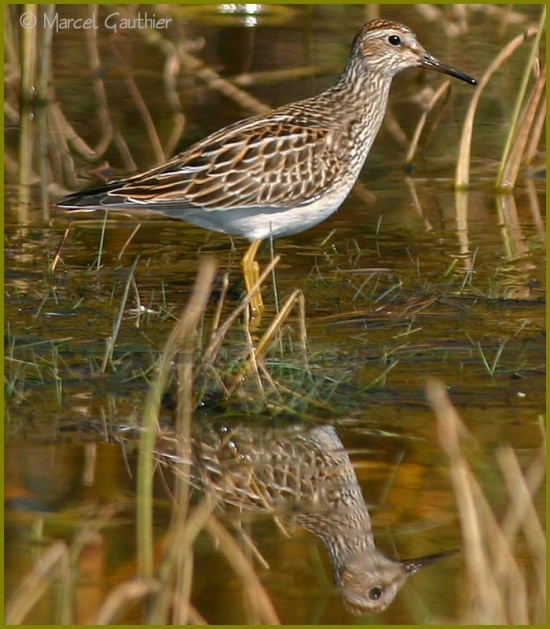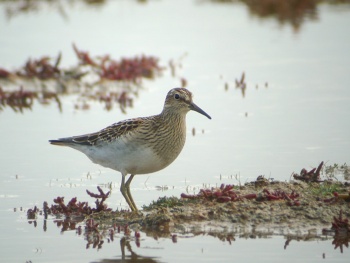(Deleted text replaced. Misc info added. References. Incomplete template gone) |
(Misc info added. Reference) |
||
| Line 2: | Line 2: | ||
;[[:Category:Calidris|Calidris]] melanotos | ;[[:Category:Calidris|Calidris]] melanotos | ||
==Identification== | ==Identification== | ||
| − | 19-23 cm | + | 19-23 cm<br /> |
| − | * | + | '''Adult''' |
| + | *Bill: | ||
| + | :*brownish-black | ||
| + | :*black tip | ||
| + | :*base often tinged olive-green or yellow-green, especially on lower mandible | ||
*Yellow legs | *Yellow legs | ||
| + | *Colour of feet varies from brownish-yellow through greenish-yellow to olive-green | ||
*Black patch on rump extending onto tail | *Black patch on rump extending onto tail | ||
*Thin, white wing stripe | *Thin, white wing stripe | ||
| − | * | + | *Dark brown Iris<br /> |
| − | Sexes similar | + | Sexes similar<br /> |
| + | '''Juvenile''': bill and feet are blackish-grey at fledging | ||
====Similar Species==== | ====Similar Species==== | ||
Flight recalls [[Ruff]] | Flight recalls [[Ruff]] | ||
==Distribution== | ==Distribution== | ||
| − | Breeds in north-east [[Siberia]] and northern [[North America]] from [[Alaska]] to Hudson Bay | + | '''Breeds''' in north-east [[Siberia]] and northern [[North America]] from [[Alaska]] to Hudson Bay. '''Winters''' in southern [[South America]] from southern [[Bolivia]] and northern [[Argentina]] to [[Paraguay]], but in smaller numbers in Pacific to [[Australia]] and [[New Zealand]]. |
In autumn most migrate via the Great Plains during July-September but large numbers gather at staging areas in south-east [[Canada]] and the north-eastern [[USA]] before flying south over the west Atlantic to [[South America]]. These birds are liable to meet with eastbound depressions bringing them across the Atlantic to [[Europe]]. | In autumn most migrate via the Great Plains during July-September but large numbers gather at staging areas in south-east [[Canada]] and the north-eastern [[USA]] before flying south over the west Atlantic to [[South America]]. These birds are liable to meet with eastbound depressions bringing them across the Atlantic to [[Europe]]. | ||
| Line 34: | Line 40: | ||
#{{Ref-Clements6thDec08}}#Collins Field Guide 5th Edition | #{{Ref-Clements6thDec08}}#Collins Field Guide 5th Edition | ||
#Collins Bird Guide ISBN 0 00 219728 6 | #Collins Bird Guide ISBN 0 00 219728 6 | ||
| + | #Parmelee et al. 1967 | ||
| + | {{ref}} | ||
==External Links== | ==External Links== | ||
{{GSearch|Calidris+melanotos}} | {{GSearch|Calidris+melanotos}} | ||
[[Category:Birds]] [[Category:Calidris]] | [[Category:Birds]] [[Category:Calidris]] | ||
Revision as of 21:54, 16 September 2009
- Calidris melanotos
Identification
19-23 cm
Adult
- Bill:
- brownish-black
- black tip
- base often tinged olive-green or yellow-green, especially on lower mandible
- Yellow legs
- Colour of feet varies from brownish-yellow through greenish-yellow to olive-green
- Black patch on rump extending onto tail
- Thin, white wing stripe
- Dark brown Iris
Sexes similar
Juvenile: bill and feet are blackish-grey at fledging
Similar Species
Flight recalls Ruff
Distribution
Breeds in north-east Siberia and northern North America from Alaska to Hudson Bay. Winters in southern South America from southern Bolivia and northern Argentina to Paraguay, but in smaller numbers in Pacific to Australia and New Zealand.
In autumn most migrate via the Great Plains during July-September but large numbers gather at staging areas in south-east Canada and the north-eastern USA before flying south over the west Atlantic to South America. These birds are liable to meet with eastbound depressions bringing them across the Atlantic to Europe.
Spring migration is mainly in April-early May and via the interior.
This is by far the most numerous Nearctic wader to occur in Europe and has been recorded in many countries from Iceland and the Faroes south to the Azores and east to Hungary, Bulgaria and Romania, also in Morocco and Israel. Annual in the British Isles, the Azores, France and Sweden.
Over 100 records in the British Isles in some years, seen throughout Britain and Ireland with most in the south-west but significant numbers in the east suggesting a Siberian rather than North American origin for many birds. Recorded throughout the year but very rare in midwinter and dramatically peaking in September-October.
Taxonomy
Monotypic[1]
Habitat
Freshwater habitats, coastal areas with damp grassland, marshland and the margins of ponds and lakes.
Behaviour
Diet
These birds forage on grasslands and mudflats, diet includes insects and other invertebrates.
Vocalisation
Flight Call: A throaty krik
References
- Clements, JF. 2008. The Clements Checklist of Birds of the World. 6th ed., with updates to December 2008. Ithaca: Cornell Univ. Press. ISBN 978-0801445019.
- Collins Field Guide 5th Edition
- Collins Bird Guide ISBN 0 00 219728 6
- Parmelee et al. 1967
Recommended Citation
- BirdForum Opus contributors. (2024) Pectoral Sandpiper. In: BirdForum, the forum for wild birds and birding. Retrieved 29 April 2024 from https://www.birdforum.net/opus/Pectoral_Sandpiper





